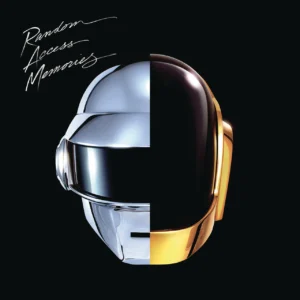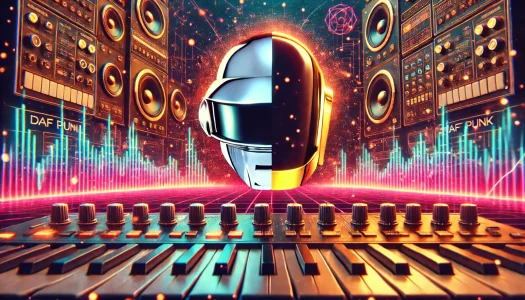Few names in electronic music command as much reverence as Daft Punk. The French duo, composed of Thomas Bangalter and Guy-Manuel de Homem-Christo, redefined the boundaries of dance music, turning what was once underground into a global phenomenon. Known for their enigmatic robot personas and genre-defying albums, Daft Punk created a sound that resonates across decades, blending nostalgia with futurism.
At the heart of their artistry lies a unique mastery: the seamless fusion of analog warmth and digital precision. By marrying vintage synthesizers, live instruments, and cutting-edge production techniques, they crafted a sonic identity that feels timeless yet always ahead of its time. This synthesis not only shaped their groundbreaking albums but also redefined the possibilities of electronic music itself.
Daft Punk’s Musical Philosophy
Daft Punk’s music is rooted in a philosophy of authenticity and fearless experimentation. From the outset, Thomas Bangalter and Guy-Manuel de Homem-Christo approached electronic music as more than a genre—it was a canvas for boundless creativity. They sought to push its limits, not simply by following trends but by setting them, often through a blend of nostalgic reverence and forward-thinking innovation.
Their respect for music history is evident in their work, which often pays homage to disco, funk, and early electronic pioneers like Kraftwerk and Giorgio Moroder. Tracks such as “One More Time” and “Lose Yourself to Dance” wear their influences proudly while reinventing these sounds for new generations. Daft Punk didn’t just imitate the past—they recontextualized it, infusing it with fresh energy and modern production techniques.
Innovation was always central to their ethos. Whether experimenting with sampling on Discovery or incorporating live orchestras and session musicians on Random Access Memories, Daft Punk approached each project with a sense of discovery and meticulous craftsmanship. They viewed their music as a dialogue between the human and the machine, crafting songs that balanced soulful expression with synthetic perfection. Their philosophy was simple yet profound: honor the traditions of the past while breaking new ground for the future.
The Analog Roots
Daft Punk’s sound was deeply anchored in the rich, tactile world of analog music production. They embraced vintage synthesizers such as the Roland Juno-106, Moog Voyager, and ARP 2600, tools known for their warm, unpredictable tones. These instruments lent their music a depth and character that stood apart from the sterile, overly polished tendencies of early digital production. By using analog equipment, Daft Punk captured a sense of immediacy and organic texture, creating sounds that felt alive and dynamic.
Beyond synthesizers, the duo incorporated live instruments to add a human touch to their compositions. Tracks like “Something About Us” from Discovery showcase their use of smooth, soulful bass lines and emotive keyboard melodies. The track’s gentle swing and slight imperfections in timing highlight their commitment to capturing the essence of a live performance, even within a meticulously produced electronic track.
This focus on humanizing electronic music became one of Daft Punk’s defining traits. They celebrated imperfections—the subtle inconsistencies and natural warmth that analog and live elements bring to music. Rather than aiming for mechanical precision, they allowed space for the unpredictability of human input, creating music that resonated emotionally while remaining unmistakably electronic. This blend of analog imperfection with electronic innovation became a hallmark of their signature sound, bridging the gap between man and machine.
Digital Innovation
While Daft Punk celebrated analog warmth, their music also thrived on the precision and versatility of digital technology. They embraced cutting-edge software and digital production techniques, using them not just to streamline their creative process but to expand the boundaries of what electronic music could achieve. From digital audio workstations to intricate layering and effects processing, they wielded digital tools with the finesse of master craftsmen.
Sampling was one of their most iconic innovations, particularly on their seminal Discovery album. Tracks like “Harder, Better, Faster, Stronger” and “One More Time” used samples from lesser-known disco and funk records, chopped, re-pitched, and restructured into entirely new forms. Daft Punk didn’t treat samples as static loops; instead, they deconstructed and manipulated them, weaving them seamlessly into their compositions. This approach transformed familiar elements into fresh sonic landscapes, blurring the lines between homage and reinvention.
The duo also used digital processing to craft unique textures and effects, such as their signature robotic vocals created through vocoders and auto-tune. Beyond vocals, they layered digital soundscapes with analog elements, using software to fine-tune every detail, from subtle reverb tails to surgically precise EQ adjustments. This meticulous approach allowed them to maintain clarity and balance while layering complex arrangements.
Key Albums as Case Studies
Homework (1997): The Raw Fusion of Analog and Digital

Daft Punk’s debut album, Homework, established their reputation as innovators in electronic music. The album’s raw, club-focused energy was built on a foundation of analog drum machines like the Roland TR-909 and early digital effects processors. Tracks such as “Da Funk” and “Around the World” exemplified this balance, combining gritty, driving basslines with precise, digitally processed loops. The album’s minimalist approach highlighted their ability to extract maximum impact from simple yet effective analog-digital interplay, creating a sound that was both immediate and timeless.
Discovery (2001): Redefining Sound Through Sampling

With Discovery, Daft Punk took a bold leap forward, using digital tools to transform their analog roots into something entirely new. Sampling played a central role in the album’s creation, with tracks like “One More Time” recontextualizing elements of late-’70s and early-’80s disco. The duo used digital manipulation to pitch-shift, chop, and layer these samples, infusing them with modern energy while retaining their nostalgic essence. Beyond sampling, Discovery showcased their knack for blending vocoder-driven vocals with lush, analog-inspired instrumentation, creating an album that was as much about emotion as it was technical innovation.
Random Access Memories (2013): A Full-Circle Return to Analog

Random Access Memories marked a deliberate return to analog roots, but with the precision and polish afforded by modern digital production. The album featured live session musicians, orchestras, and vintage equipment, from Fender Rhodes keyboards to analog tape machines, to create a lush, organic sound. Tracks like “Get Lucky” and “Giorgio by Moroder” exemplify this approach, blending analog warmth with subtle digital enhancements. The production meticulously layered live performances and analog recordings, then used digital tools for mixing and mastering, achieving a seamless, cinematic quality.
Signature Techniques
Daft Punk’s music is instantly recognizable, thanks in large part to the innovative techniques they used to blur the lines between human and machine. A hallmark of their sound is their creative use of vocoders and talkboxes to transform vocals into robotic melodies. On tracks like “Harder, Better, Faster, Stronger” and “Digital Love”, they used these tools not just as effects but as instruments, shaping vocal lines into emotive, otherworldly sounds. This approach gave their music a futuristic quality while retaining an unmistakable human touch, a perfect metaphor for their blending of analog and digital.
Their layering techniques also set them apart. Daft Punk would often combine analog synthesizers and live instruments with digitally processed sounds, carefully constructing a sonic palette that was rich and multidimensional. Analog elements provided warmth and texture, while digital layers added precision and modernity. Tracks like “Something About Us” exemplify this balance, where smooth analog basslines coexist with crisp digital percussion and subtly processed vocals.
Mixing and mastering were crucial to their sound as well. Daft Punk worked meticulously to ensure that each element—whether analog or digital—had its place in the mix. They often emphasized clarity and separation, allowing the organic imperfections of analog recordings to shine without overpowering the digital elements. Their mixing approach brought cohesion to their hybrid sound, and their mastering ensured that their tracks maintained impact and balance across various playback systems, from club speakers to headphones.
Closing Thoughts
Daft Punk’s legacy as pioneers of analog-digital fusion is unparalleled. By seamlessly blending the tactile warmth of vintage synthesizers and live instruments with the limitless possibilities of modern digital technology, they crafted a sound that redefined electronic music. Their ability to innovate while paying homage to music history set a new standard for creativity, inspiring countless artists across genres to explore the intersection of old and new.
Even after their disbandment, Daft Punk’s influence continues to resonate. Their fearless experimentation and meticulous craftsmanship have become benchmarks for music production, encouraging producers to push boundaries while maintaining authenticity. In a world where technology evolves at lightning speed, Daft Punk’s work serves as a timeless reminder: innovation thrives at the crossroads of tradition and futurism.
